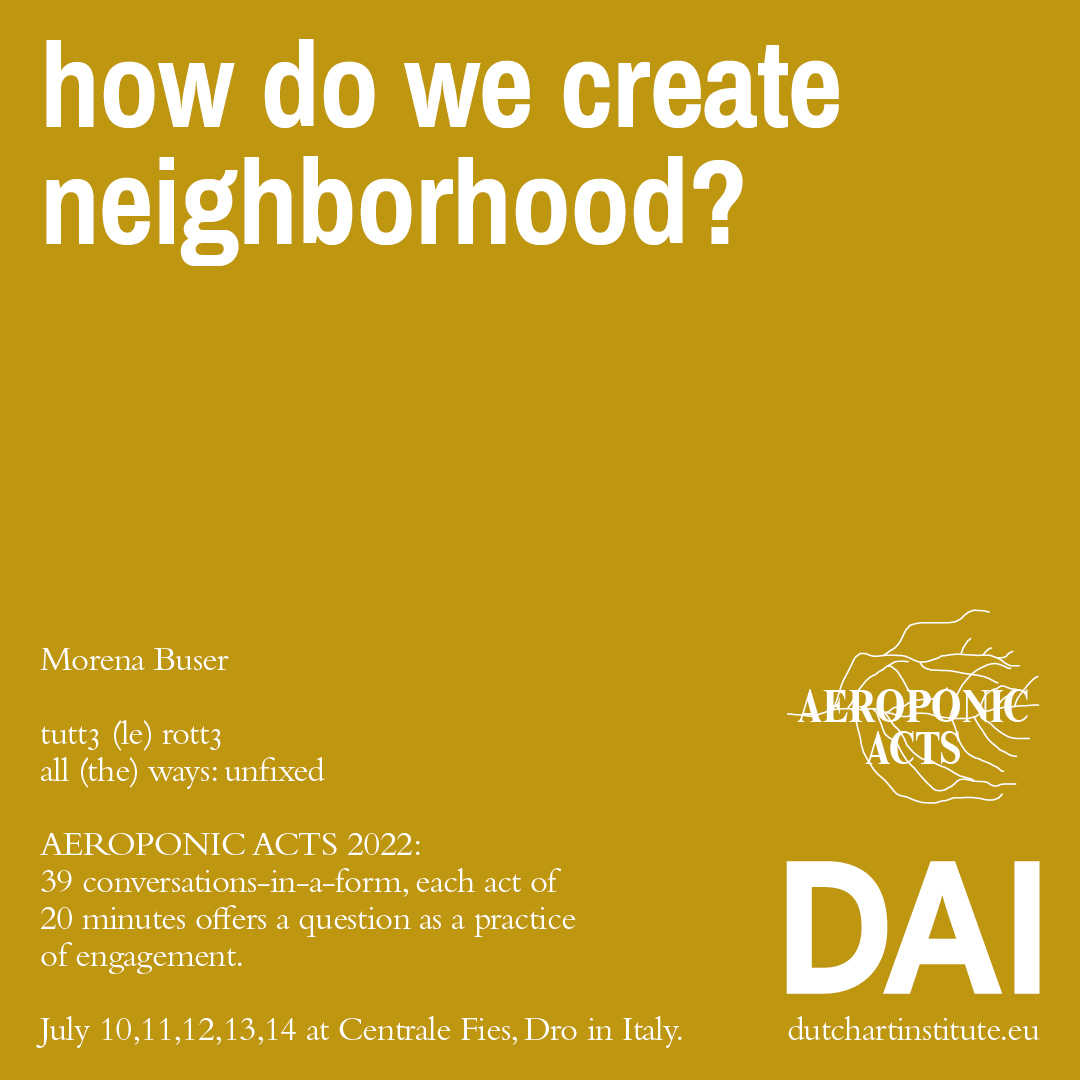Morena Buser: earth doings
‘Aeroponic’ – root systems nourished by air – Acts is the name given to the nomadic Dutch Art Institute’s final Kitchen presentations. Each participant addresses one question, as a practice of engagement.
Here you will find the documentation of Morena Buser's presentation as filmed by Baha Görkem Yalım. The written report is by Hubert Gromny and it includes a summary of the comments by esteemed guest respondents.
VIDEO COMING SOON
earth doings
Morena's question: How do we create neighborhood?
Morena's introduction: “The bird sings in the territory that makes the bird sing”—V. Despret
While the tree grows and peels, blossoms, blooms and fructifies, other beings inhabit it. There they arrive and dwell. Sometimes they nest, sometimes they feed, sometimes they are nourished, and many times they move on.
The situated knowledge of migrant wisdom opens up to potentialities and possibilities, giving rise to alternative ways of becoming. Looking closely, seriously and carefully, I name this gesture of encounter “earth doings”, towards a migrant cosmopoetics.
The vital force of migrating, of living, of making life and harboring are here shared and sung by Chono, Nujin, Zeynep, Michiko, Rocío and Viyan.
Hubert's report: In the bright space illuminated by daylight a series of small sculptures made of clay is distributed on the floor. Their surface is marked with a distinctive traces of hands and fingers, which shaped them. Their shape resembles a coral-like form of life situated between the animal and vegetal. Each sculpture contains the speaker and creates a small sound environment around itself, often being a quiet voice humming, telling a story or singing a song. Besides of it all encompassing soundscape is filling the space. Morena is present in the space walking around and streaming the situation to her mother via video-call. She distributes papers containing text which speaks about the figures of earth, feminine ancestry and soil printed in gold letters and accompanied by a pink-purple image of one of the clay beings. The audience form circles around the sculptures leaning towards them in order to hear the voices. In this way around each piece the temporary community of listeners is being created.
Chiara Figone shared about her experience of working in publishing together with a collective of women and reflections on the swarm of birds informed by this experience. A swarm of birds in that sense is a figure of collectivity but also of the movement of words. The dynamics within the swarm is complex and the roles between those who are leading and who are following are exchanged in a relay-like fashion. In the work of organizing there is a lot to learn from the swarms in terms of how temporary constellations can be created and fixity can be avoided. Within the piece interrelationship was built by using the voice as a form of transmitting and making, which allowed for knowledge to travel from one person to another. Reflecting on the question of the presentation Chiara pointed to the need to move away from fixed ways of inhabitation and to create spaces of constant becoming as necessary components in the world which consists of different migratory moments.
Ana Teixeira Pinto reformulated the question of the presentation as: how to create kinship? Reading of the text printed on the handout made Ana reflect on the darker side of the kinship by its relationship to motherly instinct. Ana pointed out that this motoring instinct has a destructive potential—as an unstoppable drive of action it is likely it could result in a crash with what it encounters on its way. From that point of view kinship can be seen not as something to aspire for, but as something claustrophobic or threatening. This question is not explicitly present within the performance nevertheless imagining and thinking on migratory forms of inhabitation demands to think how they extend beyond the feedback loop between state and heteronormative family. How can they exist and be situated within larger structures of affect, which often designate forms of aggression.
Aziza Harmel observed that in the presentation objects took the role of performers. As such the piece engaged with a certain form of animism, giving life to the matter. Drawing attention to the fragility of the sculptures and temporary character of their existence Aziza reflected on the nomadic forms of life and shared about her own family background rooted in nomadic traditions. Growing up in such a context she tended to see settlement as something not desirable. In juxtaposition to this experience Aziza evoked a collaboration with Roma curators and artists, who perceived lasting for generations nomadic state of their communities differently—not as a matter of choice but as a result of continuous debasement and dispossession. There is thus a risk of romanticizing and exotizing the figure of the nomad. Aziza observed that in the Western discourse, the idea of deterritorialization is never about an actual nomad and too often is easily translated into criticism of a desire for a stable home and roof above one's head as a social construct. Instead of rendering the opposition between settling and movement the figure of the nomad allows to think of another modality of inhabitation—a practice of inhabiting a place intensely regardless of time.
Morena Buser's "earth doings" was presented before live audience at the Centrale Fies, Dro, Italy on July 10th.
About Morena Buser
Find the overview of all 24 AEROPONIC ACTS 2022 here: tuttə (le) rottə - all (the) ways: unfixed


